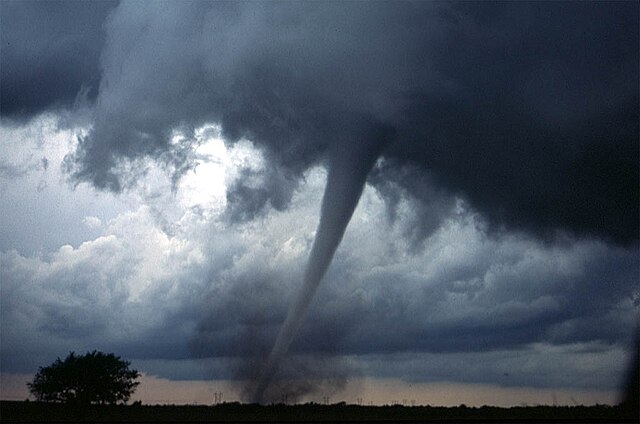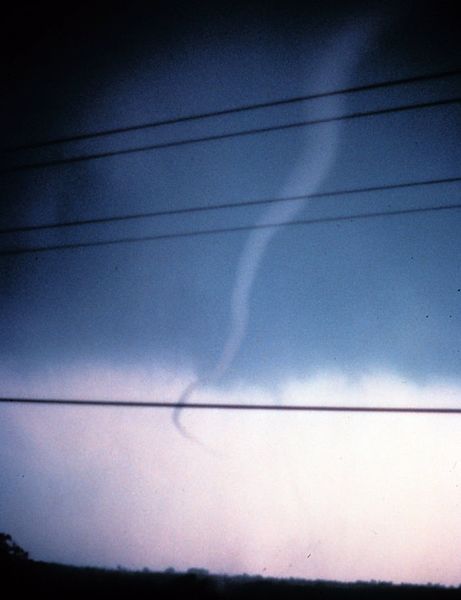Tornado intensity is the measure of wind speeds and potential risk produced by a tornado. Intensity can be measured by in situ or remote sensing measurements, but since these are impractical for wide-scale use, intensity is usually inferred by proxies, such as damage. The Fujita scale, Enhanced Fujita scale, and the International Fujita scale rate tornadoes by the damage caused. In contrast to other major storms such as hurricanes and typhoons, such classifications are only assigned retroactively. Wind speed alone is not enough to determine the intensity of a tornado. An EF0 tornado may damage trees and peel some shingles off roofs, while an EF5 tornado can rip well-anchored homes off their foundations, leaving them bare— even deforming large skyscrapers. The similar TORRO scale ranges from a T0 for extremely weak tornadoes to T11 for the most powerful known tornadoes. Doppler radar data, photogrammetry, and ground swirl patterns may also be analyzed to determine the intensity and assign a rating.

Tornado damage to a house in Oklahoma County, Oklahoma, hit during the Tornado outbreak of May 10–13, 2010
EF0 damage: This house only sustained a minor loss of shingles. Though well-built structures are typically unscathed by EF0 tornadoes, falling trees and tree branches can injure and kill people, even inside a sturdy structure. Between 35 and 40% of all annual tornadoes in the U.S. are rated EF0.
EF1 damage: Cause major damage to mobile homes and automobiles, and can cause minor structural damage to well-constructed homes. This frame home sustained major roof damage but otherwise remained intact. Around 35% of all annual tornadoes in the U.S. are rated EF1.
EF2 damage: At this intensity, tornadoes have a more significant impact on well-built structures, removing the roofs, and collapsing some exterior walls of poorly built structures. EF2 tornadoes are capable of destroying mobile homes and generating large amounts of flying debris. This home completely lost its roof, but its walls remained intact. Between 15 and 19% of all annual tornadoes in the U.S. are rated EF2.
A tornado is a violently rotating column of air that is in contact with both the surface of the Earth and a cumulonimbus cloud or, in rare cases, the base of a cumulus cloud. It is often referred to as a twister, whirlwind or cyclone, although the word cyclone is used in meteorology to name a weather system with a low-pressure area in the center around which, from an observer looking down toward the surface of the Earth, winds blow counterclockwise in the Northern Hemisphere and clockwise in the Southern. Tornadoes come in many shapes and sizes, and they are often visible in the form of a condensation funnel originating from the base of a cumulonimbus cloud, with a cloud of rotating debris and dust beneath it. Most tornadoes have wind speeds less than 180 kilometers per hour, are about 80 meters across, and travel several kilometers before dissipating. The most extreme tornadoes can attain wind speeds of more than 480 kilometers per hour (300 mph), are more than 3 kilometers (2 mi) in diameter, and stay on the ground for more than 100 km (62 mi).

A tornado approaching Elie, Manitoba, Canada in June 2007.
A tornado near Anadarko, Oklahoma, 1999. The funnel is the thin tube reaching from the cloud to the ground. The lower part of this tornado is surrounded by a translucent dust cloud, kicked up by the tornado's strong winds at the surface. The wind of the tornado has a much wider radius than the funnel itself.
This tornado has no funnel cloud; however, the rotating dust cloud indicates that strong winds are occurring at the surface, and thus it is a true tornado.
A rope tornado in its dissipating stage, found near Tecumseh, Oklahoma.








